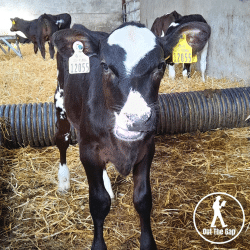Out The Gap – Issue 3


Dairy Breeding Season
As we finish up calving, the focus will turn to the breeding season next. Fertility is a critical factor in the productivity and profitability of this season resulting in optimal conception rates and calving intervals. This not only maximizes milk production but also reduces the incidence of reproductive disorders and associated costs. Selecting sires with high fertility traits can improve the reproductive performance of the herd and using appropriate breeding techniques, farmers can progress the genetic potential of their herds, improving productivity and profitability.
Successful breeding of dairy cows involves many factors. During the breeding season, cows require a diet high in energy, protein and essential minerals and vitamins. Protein is particularly important during the breeding season as it is involved in the development and maintenance of the reproductive organs, as well as the production of reproductive hormones. Cows require a diet with high-quality protein sources, such as soybean meal or alfalfa, to support reproductive function. Energy is also essential for reproductive performance as it provides the cow with the necessary energy reserves to support ovulation, fertilization and early pregnancy.
Another factor that can impact fertility, healthy calving and overall production is an inadequate mineral and vitamin supplementation. Correct mineral levels result in improving reproduction rates. Low copper levels are correlated with weak heats, poor fertility, retained placenta. Low selenium levels result in retained placenta, weak stillborn calves. Cobalt is required for conception. Low iodine levels have been linked to failed conception and cows not holding. If you are concerned, a grass analysis or a blood/milk mineral analysis is suggested. 
Additionally, P deficiency can lead to an increased risk of pregnancy loss, particularly in the early stages of pregnancy. Cows require different levels of P at different stages of their reproductive cycle. Cows in early lactation require higher levels of P to support milk production. In addition to dietary management, other factors can impact the availability of P to cows. For example, high levels of dietary calcium can reduce the absorption of P in the gut, leading to P deficiency. Maintaining adequate levels of P in the diet of dairy cows early is essential for ensuring optimal reproductive performance and reducing the risk of fertility disorders.
Here are some tips for managing the breeding season effectively:
- Establish a Breeding Plan/ Plan ahead: The breeding plan should be based on the cow’s reproductive history, age, and overall health status. The plan should outline the timing of breeding and the selection of sires based on genetic merit, resulting in high conception rates and reduced calving intervals.
- Monitor Reproductive Status: Begin pre breeding heat detection. Apply one colour tail paint to all cows calved greater than 35 days in the morning after milking. Keep a record of any cows not seen bulling and get them examined.
- Address Health Issues: Sick / stressed cows are less likely to conceive and carry a healthy calf. Pull out a problem cow group before breeding and get them checked. Problems such as: milk fever, twins, difficult calving, held cleanings or sick since calving time. Regular veterinary check-ups, vaccination schedules, and parasite control programs can help keep cows healthy and improve reproductive outcomes. Body condition scoring (BCS) is also critical, as cows that are too thin or too fat may experience fertility issues. The target BCS for breeding is between 2.9 to 3.25.
- Implement a Record-Keeping System: Maintaining accurate records of breeding dates, pregnancy status, and calving dates can be used to track cow productivity and identify areas for improvement in the breeding program. Milk recording nationally is growing and herds of all sizes are seeing the benefits, you can’t manage what you don’t measure. Milk recording highlights your best and worst performers in terms of their milk production. This information combined with EBI is key to making the most profitable breeding decisions for the future.
- Employ Technology: Advancements in technology have made it easier for farmers to manage the breeding season. Tools like heat detection systems, artificial insemination, and embryo transfer can help farmers to achieve optimal breeding outcomes.
Optimal fertility and successful breeding season management requires a comprehensive approach that considers all aspects of the cow’s health and reproductive performance. By managing nutrition, planning and monitoring reproductive status, and employing effective breeding methods, farmers can maximize the reproductive potential and optimize their breeding outcomes of their dairy cows, achieving long-term success.
Breed easy folks!

